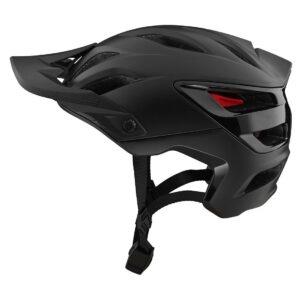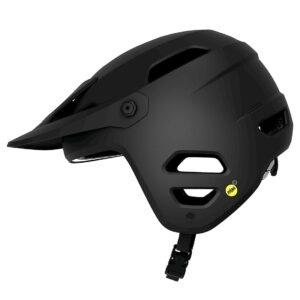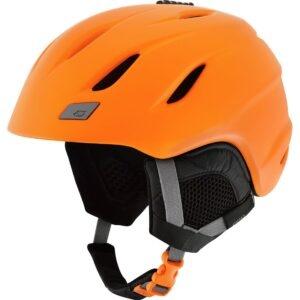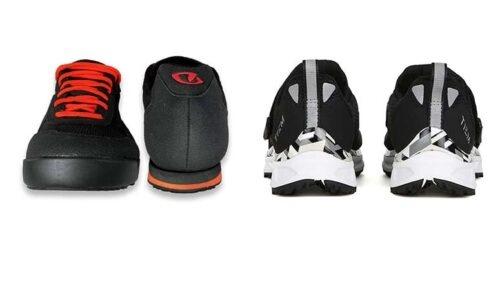Just because the temperature drops doesn’t mean you can’t head out on your bike in the winter. You need to adapt what you wear to stay warm and protect yourself from the elements, but it should be business as usual, as long as you don’t have to contend with a thick layer of snow.
You may want to switch your regular bike helmet with a winter bike helmet. So in this article, we’ll give you some tips for buying the best winter bike helmet for you. We’ll also give you some recommendations for our favorite ones.
What To Look For In The Best Winter Bike Helmet
Look At What It’s Made From
Like your regular helmet, your winter bike helmet should be made from materials that keep your head safe. The best winter bike helmet will be CPSC or ASTM certified, meaning they meet specific safety standards.
Bike helmets have a hard plastic shell with an EPS (Expanded PolyStyrene) liner. The liner absorbs the shock from impacts and disperses it around the helmet, protecting your head. Other materials, such as Koryod, are used in liners, but EPS is the most common.
Make Sure It Is Ventilated
Even though you’ll ride in colder temperatures, you’ll still need some ventilation. Pedaling will still make your head sweaty, so you’ll want some cool air coming in at the front and warm air exhausting out the back of the helmet.
Therefore, look for a winter bike helmet with fewer ventilation holes than your regular helmet.
Warmth
 It would be best if you also balanced your ventilation with warmth. You can buy winter bike helmets with cozy liners, which are removable, so you tweak how much insulation you have around your head.
It would be best if you also balanced your ventilation with warmth. You can buy winter bike helmets with cozy liners, which are removable, so you tweak how much insulation you have around your head.
They make cleaning your helmet much more straightforward. In addition to this, you may be able to wear the helmet in summer by removing the liner.
Some helmets have thicker ear pads. Check if these are removable, as you may not want the extra insulation all the time. You may also want to check if the earpads are audio-ready so that you can listen to music on your ride.
Consider How Much Coverage You Need
The type of helmet you buy will depend on the kind of riding you do and how extreme the weather conditions are. You’ll benefit from wearing a helmet with a visor, as it stops rain from running into your eyes and protects them from the sun and wind.
You may want a full-face helmet if you’re mountain biking. This may be a good idea if the terrain you ride is heavily affected by bad weather and snow, causing you to fall off your bike more.
Downhill mountain bike helmets are warmer, as they have fewer ventilation holes, but they are a little heavier and may be overkill if your terrain is pretty mellow.
If you don’t go for a full-face helmet, you may want to wear a face covering. But make sure it’s breathable, as it can get wet from your breath, making it uncomfortable.
Make Sure It’s Not Too Heavy
Winter bike helmets are heavier than regular ones due to the extra insulation and reduced ventilation. But if you choose a winter bike helmet that’s excessively heavy, you’ll feel uncomfortable, and your neck will become sore on long rides trying to support the weight.
Get The Perfect Fit
Your bike helmet must fit you correctly so it’s comfortable and does its job if you fall and hit your head. Therefore, your first step is choosing a helmet the correct size for your head. Measure around your head, just above your eyebrows, and follow the manufacturer’s sizing instructions on their website.
Then you need to fine-tune the helmet for the perfect fit. Some helmets come with a selection of pads with varying thicknesses. You can swap these in and out until your helmet feels comfortable and secure.
Some helmets also come with a dial on the back. This allows you to tighten and loosen your helmet for the perfect fit.
Our Top 5 Picks For The Best Winter Bike Helmet
1.Troy Lee Designs A3 MIPS Uno

The Troy Lee Designs A3 MIPS Uno is one of the most comfortable mountain bike helmets. It is a trail-riding helmet with lots of coverage around your head, especially at the back.
You’ll feel well-insulated thanks to the soft and durable padding, which does a fine job of protecting your head too. This is an in-mold helmet, meaning the outer shell is molded to the EPS foam, making it more durable.
Troy Lee has made the A3 a MIPS helmet that uses a slip plane that reduces rotational forces in a crash. This is reassuring when you ride in tricky winter conditions that might cause you to fall off your bike.
2. Smith Forefront 2 MIPS
The Smith Forefront 2 MIPS is a high-end half-shell bike helmet with a whole host of great features. First of all, it’s compatible with goggles, which is great if you’re riding in bad weather and the adjustable visor allows you to adjust the coverage and block out the sun.
One of the most significant features of the Smith Forefront 2 is its superb fitting system. It uses the VaporFit dial adjustment system, which offers a 270-degree fit adjustment, so you can tweak the fit to make your helmet as comfortable and secure as possible.
Protection comes from the innovative Koroyd technology. This reduces energy from crashes from all angles. It is a honeycomb-like construction that crumples when the helmet receives a blow. The other advantage of Koroyd is that it makes the helmet super lightweight, so your neck won’t feel the strain when riding bumpy terrain.
The Smith Forefront is a great winter bike helmet, as the Koroyd system covers the helmet’s ventilation holes, retaining heat.
3. Giro Tyrant

The Giro Tyrant is a trail helmet with added protection, making it an excellent choice for gnarly winter riding. The extra protection comes from additional coverage over the ears and side of the head. This also means you get more insulation, keeping your head warm.
Giro has used MIPS in this helmet. This, combined with the in-mold construction, you get peace of mind that you’re well protected if you and your bike part ways.
Weighing 620g, the Giro Tyrant isn’t the lightest helmet, but you get more coverage than other bike helmets. So you need to decide what is important to you. This helmet is for the trail rider who wants more protection and isn’t put off riding by the weather.
4. Giro Timberwolf (Backcountry.com)

If you ride in particularly cold places, you may want to check out the Giro Timberwolf, as it is designed for winter riding. Giro has based the design on a ski helmet, using a similar shape and features. Therefore you get the supreme comfort of a ski helmet too.
The Giro Timberwolf is a cozy helmet, thanks to the fleece liner, so you don’t have to wear a hat under it to stay warm. But, you can also prevent getting too warm by opening the ventilation holes or closing them when the temperature drops. The other advantage of adjustable ventilation is that you can close the holes to prevent snow and rain from getting in.
We love that the earpads are removable. This makes it easy to fine-tune your comfort according to the weather. Leave them attached on cold days, or pop them out when the temperature starts to rise.
This helmet has an in-mold construction, so the hard plastic shell is bonded to the impact-absorbing EPS foam layer. The result is a lightweight and durable helmet, so you can stay comfortable when riding long distances.
Even though the Giro Timberwolf is an excellent winter bike helmet, it doesn’t have MIPS, which is a shame, as MIPS adds an extra element of protection in a crash.
Riding at night or in low light conditions is a large part of winter riding. Therefore, Giro has fitted the Timberwolf with an attachment for a light on the back. This helps to alert other road users to your presence in the dark, adding to your safety.
The Giro Timberwolf is an excellent choice for those who want a well-fitting, comfortable, warm bike helmet for winter riding.
5. Tough Headwear Skullcap
You may not want to buy a new helmet for winter riding, but that doesn’t mean you have to get brain freeze. This skullcap from Tough Headwear fits snuggly over your head and ears but has a low profile so that you can fit your bike helmet over the top.
The polyester/spandex material used in this cap wicks moisture away from your head and dries quickly, keeping you comfortable. The material is also stretchy and lightweight, further enhancing comfort.
Final Thoughts
Now you know what to look for in the best winter bike helmet, and we’ve given you some excellent options to choose from.
Just remember to ensure that you get the correct size and that it fits you well. If you don’t, your comfort and safety will be compromised.

Tom Fortune has been reviewing cycling products for several years from his home in the French Alps. As the owner of mtb-threads.com, he mainly reviews mountain bike products but also reviews road cycling products independently.



